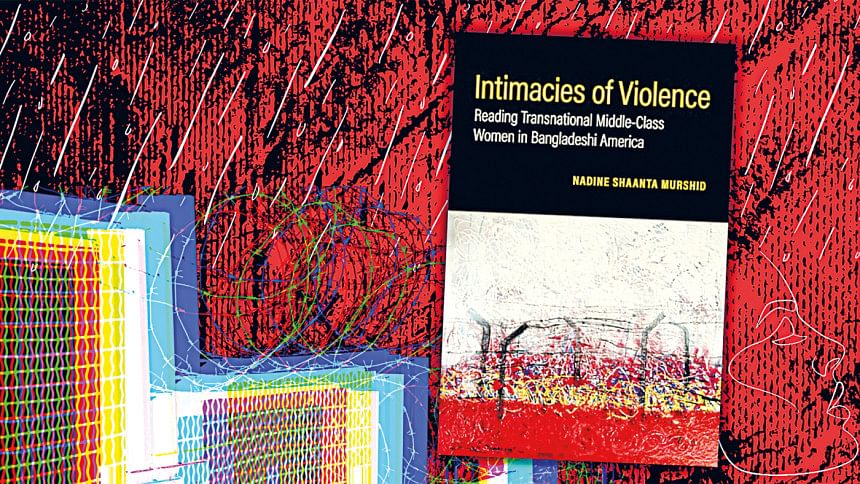Confronting cultural silence on IPV in Bangladeshi communities

Proverbs, short and profound, often sum up wisdom passed down through generations. Bangla, one of the world's most spoken languages, is rich with such gems. One such saying in the language—"manush ki bolbe?"—is central to Intimacies of Violence, a debut book by Dr Nadine Shaanta Murshid, an associate professor at the University at Buffalo.
The book presents a decade-long exploration of intimate partner violence (IPV) among Bangladeshi Muslim women in Dhaka and New York. Through interviews with 40 women, Murshid critiques the middle-class values and cultural norms that enable and perpetuate IPV. Divided into four parts, "Intimacies"; "Kinship Ties"; "Nation and Nationalism"; and "Embodying Structural Violence", each section addresses different facets of IPV within Bangladeshi communities in a sharp, engaging tone. The narrative offers a wealth of insights for readers interested in gender, migration, culture and South Asian studies. It is also written in easy yet elegant English, and as an academic research, it is a highly engaging read. Readers of Dr Murshid's columns on Bangladeshi newspapers and blogs, of course, would be familiar with her style.
It is a nice take on Kamini Roy's poem, "Pachhe Loke Kichhu Bole" (Lest They Say Something), written in the 19th century. The poem aptly expressed as well as criticised women for their fear of breaking social norms.
As the title suggests, the book explores the violence suffered by young Bangladeshi females, in varying contexts, inflicted by their (male) partners, who in most cases, especially from outside of the relationships, may appear normal, non-aggressive, even caring. However, abusive partners are only half of the story. The other perpetrators are: Bangali communities, culture, religion and society at large. Elderly roles, such as that of aunties and mothers, play a discursive but active part in tolerating and thwarting intimate partner violence, which maintains the problem of partner violence in Bangladeshi communities.
Why do they do it though—in desh and abroad? The answer lies in an idiom that Dr Murshid uses frequently throughout the prose: manush ki bolbe (what would people say?). It is a nice take on Kamini Roy's poem, "Pachhe Loke Kichhu Bole" (Lest They Say Something), written in the 19th century. The poem aptly expressed as well as criticised women for their fear of breaking social norms. It is a true yet poignant illustration of Bangali society during the British colonial period when women sacrificed their desires, creativity, or opportunities that were naturally available to men, which benefited men and stifled ambition, aspiration, and independent thinking and self-reliance of women. Perhaps the poem was to inspire progressive thinking in society, especially for women to shrug off inhibitions and self-consciousness in pursuit of their intellectual as well as human growth.
Likewise, Murshid's research findings are scathing of the Bangladeshi middle class, specially of the women who continue their enabling roles, which, as in poet Roy's days (and alas also now) is mostly benefiting the men (from sacrifices made by women). An omnipresent fear of social stigma follows victims of partner violence who are usually blamed rather than the perpetrators for the violence they experience. Men are seen as human beings–capable of making mistakes and deserving of understanding. What Murshid wants is for that same humanity to be available to women.
The book's section on kinship ties highlights the complex roles of "aunties" in perpetuating IPV. Murshid describes aunties as both enablers and potential allies: some demean victims, aligning with patriarchal norms, while others provide support. These aunties, acting as cultural gatekeepers, wield significant influence over women's lives, whether in Dhaka or in New York.
One of the book's most striking chapters addresses the legacy of the Birangona—a term honouring rape survivors of the 1971 Bangladesh Liberation War. Murshid critiques the politicisation of these survivors' narratives, arguing that glorification often obscures their lived realities and reinforces harmful gender norms. Women are burdened with the societal expectation of maintaining honour, leading to silence around rape and IPV. Murshid uses poignant examples, such as Tufan's painting of a submissive woman depicted as a chair, to illustrate how society views women as objects to be used and discarded or ignored. The chapter also examines how class plays a role in navigating violence: while middle-class women may conceal abuse through migration or marriage, those from poorer backgrounds face more overt stigma but also greater opportunities to escape.
In the book's final section, Murshid explores how migration shapes women's experiences of IPV. Many Bangladeshi women migrate to the U.S. expecting liberation, only to encounter familiar constraints within diasporic communities. Interviewees recount navigating societal taboos, professional bias, and legal systems that often fail to address their needs. Murshid highlights how diasporic families often enforce stricter controls over women, particularly around sexuality, than their counterparts in Bangladesh. This hyper-vigilance discourages women from reporting abuse and perpetuates cycles of silence. Even second-generation women face similar restrictions, revealing how deeply entrenched these norms are.
The legal system, too, presents challenges. Murshid describes how victims of IPV struggle to prove abuse, especially when it involves psychological or sexual coercion, which are often unrecognized as crimes. This burden of proof, coupled with systemic biases, leaves many women without recourse.
Murshid situates IPV within the broader frameworks of capitalism and neoliberalism, which she argues exacerbate women's vulnerabilities. Capitalism pits middle-class women against one another in a competition for resources, while neoliberalism promotes isolation and individualism, making collective action against IPV more difficult. In the diaspora, neoliberal ideals also empower Bangladeshi men to manipulate women's vulnerabilities, often threatening to send them 'back home'. Murshid critiques how consumerism commodifies love, reducing it to material gestures rather than genuine care. While millennials resist some patriarchal norms, such as arranged marriages, they often remain bound by what may appear to be cultural expectations, but is often about "belonging".
While the book provides no easy solutions to these problems, it underscores the importance of education, acknowledgment, and systemic reform. The author's ideological stance against capitalism and neoliberalism may not resonate with all readers, but her insights into the lived experiences of Bangladeshi women are compelling and necessary.
Intimacies of Violence is a significant contribution to feminist scholarship, especially on Bangladeshi middle class Muslims, and South Asian studies, shedding light on a topic often silenced within Bangladeshi communities. This book deserves a wide readership, not only among academics but also among Bangladeshi families, guardians, and community leaders. If we are to address IPV meaningfully, we must first allow victims to speak without fear or stigma—and Murshid's work is a step toward that goal.
A global release of the book is expected in January. It can be purchased online from Oxford University Press.
Irfan Chowdhury is an opinion writer.

 For all latest news, follow The Daily Star's Google News channel.
For all latest news, follow The Daily Star's Google News channel. 








Comments